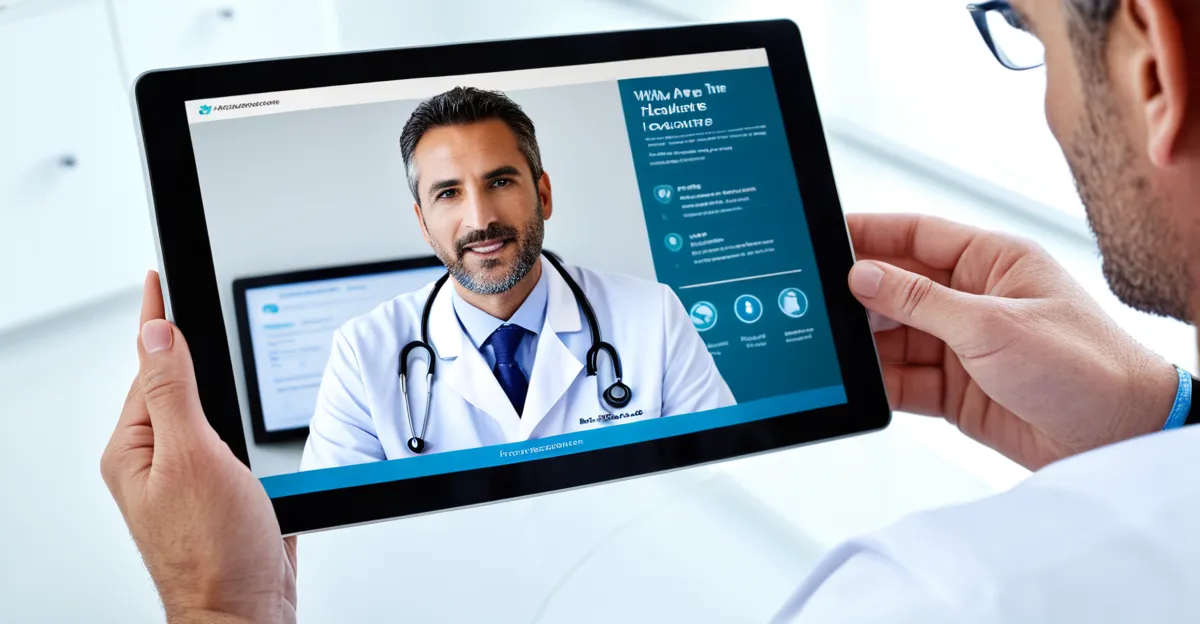Overview of Telemedicine in the UK
Telemedicine has significantly transformed the landscape of UK Healthcare by leveraging Digital Health technologies. This innovative approach allows healthcare services to be delivered remotely, enabling patients to consult with healthcare professionals without the need for physical visits. The evolution of telemedicine in the UK has been driven by the need to enhance healthcare accessibility and efficiency, catalysed by technological advancements.
Adoption of telemedicine in the UK has gained momentum, particularly following the COVID-19 pandemic, which highlighted the critical role of remote consultations. As healthcare systems sought to minimize physical contact, telemedicine emerged as a viable solution, facilitating patient care continuity while adhering to safety measures.
Have you seen this : What are the Unseen Benefits of Herbal Remedies in UK Healthcare?
Key government initiatives have played a critical role in promoting telehealth. The UK government has invested in digital infrastructure and policy frameworks to support the growth of telemedicine, aiming to reduce pressure on traditional healthcare facilities and improve patient outcomes. These initiatives have included financial incentives for healthcare providers adopting digital solutions, alongside strategic partnerships with technology firms to ensure robust and secure service delivery. Such efforts signify the government’s commitment to integrating telemedicine as a permanent component of the healthcare system, catering to the evolving needs of patients.
Increased Accessibility
Telemedicine has been pivotal in enhancing accessibility to healthcare, especially for rural and underserved populations. By facilitating remote consultations, it bridges the gap for individuals who previously found it challenging to access medical services due to geographical barriers. This is particularly beneficial for areas where healthcare facilities are sparse, ensuring that all patients, regardless of location, can receive timely advice from healthcare professionals.
Topic to read : How are UK schools promoting mental health awareness among students?
For patients with mobility issues, telemedicine offers significant advantages. Instead of the cumbersome task of traveling to and from healthcare facilities, individuals can participate in consultations from the comfort of their homes. This not only saves time but also reduces the strain on patients managing chronic conditions.
Illustrative case studies have shown remarkable improvements in patient reach and accessibility through telemedicine. For instance, the implementation of telehealth services in remote Scottish islands has drastically reduced the need for physical visits, linking patients directly with specialists via digital platforms. This showcases the transformative impact of telemedicine in providing equitable healthcare access for all.
Convenience for Patients
The convenience brought about by telemedicine is a significant contributor to its rising popularity among patients within the UK. By allowing for online consultations, patients experience a notable reduction in travel and wait times. This particularly benefits those who, prior to telemedicine’s introduction, needed to plan their day around costly and time-consuming trips to healthcare facilities.
Flexibility in Scheduling
One of the standout features of telemedicine is the flexibility it offers regarding scheduling appointments. Patients can now choose consultation times that best fit their schedules, including options outside traditional office hours. This flexibility is crucial for working individuals or those managing family responsibilities, allowing them to more easily integrate healthcare consultations into their day-to-day lives.
Impact on Patient Satisfaction
Patient satisfaction has significantly improved with the introduction of online consultations, as this method not only enhances ease of access but also promotes better adherence to treatment plans. By streamlining the process of meeting with healthcare professionals, patients are more likely to attend scheduled appointments and maintain regular check-ups, all of which are critical to managing health proactively. This positive impact on adherence further emphasizes telemedicine’s role in shaping a patient-centred approach to care.
Cost-Effectiveness of Telemedicine
Telemedicine offers notable cost savings for both healthcare providers and patients, contributing to the financial efficiency of the UK healthcare system. By reducing the need for physical infrastructure and associated expenses, healthcare providers can allocate resources more effectively. Patients also benefit financially through decreased travel expenses and reduced time away from work.
In terms of direct healthcare expenses, telemedicine has been effective in lowering hospital admissions and emergency room visits. Remote consultations play a critical role in early detection and management of health issues, preventing the escalation of conditions that require expensive inpatient care. These preventative measures contribute significantly to the reduction in overall healthcare costs.
When comparing telemedicine costs to traditional healthcare expenditures, the savings become even more apparent. Online consultations tend to be less resource-intensive than in-person visits, thereby decreasing the operational costs for healthcare facilities. The affordability of telemedicine for routine consultations positions it as a sustainable solution in the long term, promoting financial efficiency and accessibility across the UK.
Improved Patient Outcomes
Telemedicine is transforming patient outcomes in the UK by elevating the quality of care and enhancing health monitoring. Evidence suggests that the strategic implementation of telemedicine has led to marked improvements in health outcomes, particularly for individuals managing chronic diseases. This is largely due to more frequent and accessible interaction with healthcare professionals, enabling timely interventions and more personalized care plans.
For patients with chronic conditions such as diabetes or hypertension, telehealth initiatives offer significant advantages by facilitating regular, virtual check-ins. These virtual follow-ups ensure that any changes in health status are promptly addressed, thereby preventing complications that may otherwise escalate in the absence of continuous monitoring. As a result, patients experience a more proactive approach to managing their health, which contributes substantially to positive long-term outcomes.
Moreover, telemedicine supports a comprehensive view of patient health by integrating digital health tools such as wearable devices. These tools allow practitioners to access real-time data on vital signs, providing them with the information needed to make informed decisions quickly. This fosters a two-way communication channel between patients and healthcare providers, ultimately enhancing the overall quality of care delivered.
In summary, the incorporation of telemedicine into the UK healthcare system is proving to be instrumental in improving patient outcomes, demonstrated by the enhanced management of chronic diseases and the effectiveness of virtual follow-ups. The availability of continuous care and monitoring significantly contributes to the welfare of patients, making telemedicine a cornerstone of modern healthcare practices.
Challenges and Limitations of Telemedicine
While telemedicine offers numerous benefits, it faces several challenges and limitations that can impact its effectiveness. One of the primary barriers is the lack of access to high-speed internet, especially in rural or underserved areas. This limitation prevents some populations from fully utilizing remote consultations, creating a digital divide in healthcare accessibility.
Furthermore, regulatory and reimbursement challenges present obstacles in the widespread adoption of telemedicine. Inconsistent regulations and policies concerning telehealth services can complicate the integration of these technologies into standard healthcare practices. Additionally, discrepancies in reimbursement schemes may discourage healthcare providers from offering telemedicine services.
Concerns over privacy and data security in virtual consultations also pose significant challenges. The handling of sensitive patient information online necessitates stringent security measures to protect against potential breaches. As telemedicine continues to evolve, addressing these barriers is crucial for maximizing its potential benefits in the UK healthcare system.
Future Developments and Trends
Telemedicine’s future in the UK promises exciting shifts, driven by emerging technologies like AI and wearable health devices. These innovations offer enhanced digital health services, facilitating more nuanced patient care. AI-powered diagnostics can predict potential health issues, enabling proactive patient management. Meanwhile, wearables provide continuous health data, fostering timely interventions. In response to telemedicine’s growing value, the government is expected to further invest in digital health infrastructure. Upcoming policies may include increased funding, aimed at bridging existing technological gaps and supporting rural areas. Furthermore, secure platforms for patient data will be crucial in maintaining privacy while enhancing digital consultations. As telehealth models evolve, the UK is positioned to lead in integrating technology within healthcare, setting standards for global practices. This trend underscores the necessity for continued innovation and the broadening scope of telemedicine services.
Case Studies and Real-World Examples
In the realm of telemedicine, numerous case studies highlight successful implementations that underscore its transformative potential in the UK, particularly within public health entities like the NHS. These success stories demonstrate how telehealth has enhanced patient care delivery and accessibility.
-
NHS Implementation: The National Health Service has been at the forefront of integrating telemedicine into its healthcare provision. One standout example is the use of remote consultations in dermatology, where patients can send images of skin conditions to specialists. This has significantly expedited diagnosis and treatment, reducing wait times and improving patient outcomes.
-
Patient Testimonies: Feedback from patients utilizing telehealth services often points to increased satisfaction due to the convenience and flexibility offered. Individuals managing chronic conditions, such as asthma or diabetes, report improved health monitoring and easier access to specialists, leading to better management of their conditions.
-
International Comparisons: When comparing UK’s telehealth systems with international models, like those in Sweden and Australia, it’s evident that the UK’s commitment to digital health technologies is robust. These nations have similar challenges with rural populations, and the UK’s proactive strategies in telemedicine are setting a competitive pace, showcasing efficiency and broad-reaching access.
Such real-world examples not only attest to the efficacy of telehealth but also highlight areas for growth and innovation, ensuring that the UK remains at the forefront of digital healthcare advancements.
Conclusion on Telemedicine’s Impact
Telemedicine has indelibly transformed the UK Health System, fostering an era of interactive and accessible healthcare. The integration of Digital Health initiatives has led to remarkable improvements in service delivery, particularly through boosted accessibility and enhanced patient outcomes. However, balancing opportunities with inherent challenges remains critical. As technology progresses, overcoming barriers such as internet access limitations and privacy concerns will be vital to harnessing the full potential of telehealth. Looking ahead, sustained innovation and government support are essential to advancing and refining these services. This pathway promises a robust future outlook for the UK’s healthcare landscape, with telemedicine playing an increasingly pivotal role in shaping equitable and efficient medical care.








